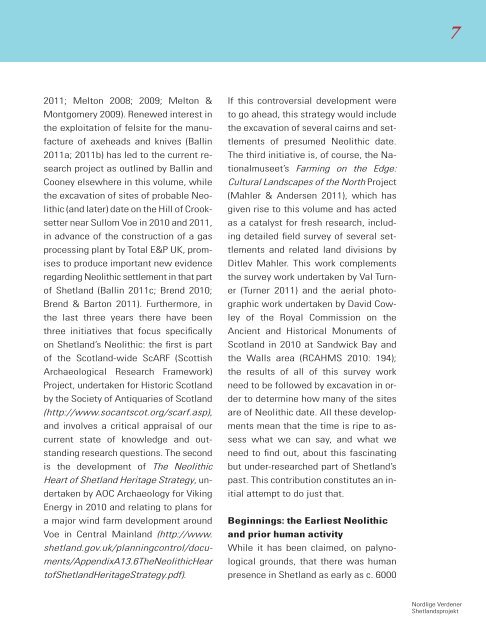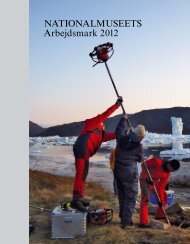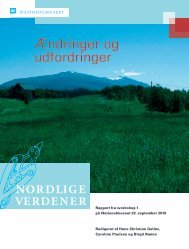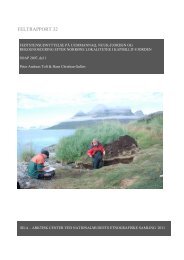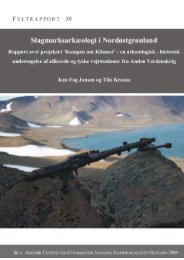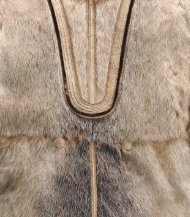The Border of Farming and the Cultural Markers - Nordlige Verdener
The Border of Farming and the Cultural Markers - Nordlige Verdener
The Border of Farming and the Cultural Markers - Nordlige Verdener
Create successful ePaper yourself
Turn your PDF publications into a flip-book with our unique Google optimized e-Paper software.
7<br />
2011; Melton 2008; 2009; Melton &<br />
Montgomery 2009). Renewed interest in<br />
<strong>the</strong> exploitation <strong>of</strong> felsite for <strong>the</strong> manufacture<br />
<strong>of</strong> axeheads <strong>and</strong> knives (Ballin<br />
2011a; 2011b) has led to <strong>the</strong> current research<br />
project as outlined by Ballin <strong>and</strong><br />
Cooney elsewhere in this volume, while<br />
<strong>the</strong> excavation <strong>of</strong> sites <strong>of</strong> probable Neolithic<br />
(<strong>and</strong> later) date on <strong>the</strong> Hill <strong>of</strong> Crooksetter<br />
near Sullom Voe in 2010 <strong>and</strong> 2011,<br />
in advance <strong>of</strong> <strong>the</strong> con struc tion <strong>of</strong> a gas<br />
processing plant by Total E&P UK, promises<br />
to produce important new evidence<br />
regarding Neolithic settlement in that part<br />
<strong>of</strong> Shetl<strong>and</strong> (Ballin 2011c; Brend 2010;<br />
Brend & Barton 2011). Fur<strong>the</strong>rmore, in<br />
<strong>the</strong> last three years <strong>the</strong>re have been<br />
three initiatives that focus specifically<br />
on Shetl<strong>and</strong>’s Neolithic: <strong>the</strong> first is part<br />
<strong>of</strong> <strong>the</strong> Scotl<strong>and</strong>-wide ScARF (Scottish<br />
Archaeological Research Frame work)<br />
Project, undertaken for Historic Scotl<strong>and</strong><br />
by <strong>the</strong> Society <strong>of</strong> Antiquaries <strong>of</strong> Scotl<strong>and</strong><br />
(http://www.socantscot.org/scarf. asp),<br />
<strong>and</strong> involves a critical appraisal <strong>of</strong> our<br />
current state <strong>of</strong> knowledge <strong>and</strong> outst<strong>and</strong>ing<br />
research questions. <strong>The</strong> second<br />
is <strong>the</strong> development <strong>of</strong> <strong>The</strong> Neolithic<br />
Heart <strong>of</strong> Shetl<strong>and</strong> Heritage Strategy, undertaken<br />
by AOC Archaeology for Viking<br />
Energy in 2010 <strong>and</strong> relating to plans for<br />
a major wind farm development around<br />
Voe in Central Mainl<strong>and</strong> (http://www.<br />
shetl<strong>and</strong>.gov.uk/planningcontrol/documents/AppendixA13.6<strong>The</strong>NeolithicHear<br />
t<strong>of</strong>Shetl<strong>and</strong>HeritageStrategy.pdf).<br />
If this controversial development were<br />
to go ahead, this strategy would include<br />
<strong>the</strong> excavation <strong>of</strong> several cairns <strong>and</strong> settlements<br />
<strong>of</strong> presumed Neolithic date.<br />
<strong>The</strong> third initiative is, <strong>of</strong> course, <strong>the</strong> Nationalmuseet’s<br />
<strong>Farming</strong> on <strong>the</strong> Edge:<br />
<strong>Cultural</strong> L<strong>and</strong>scapes <strong>of</strong> <strong>the</strong> North Project<br />
(Mahler & Andersen 2011), which has<br />
given rise to this volume <strong>and</strong> has acted<br />
as a catalyst for fresh research, including<br />
detailed field survey <strong>of</strong> several settlements<br />
<strong>and</strong> related l<strong>and</strong> divisions by<br />
Ditlev Mahler. This work complements<br />
<strong>the</strong> survey work undertaken by Val Turner<br />
(Turner 2011) <strong>and</strong> <strong>the</strong> aerial photographic<br />
work undertaken by David Cowley<br />
<strong>of</strong> <strong>the</strong> Royal Commission on <strong>the</strong><br />
Ancient <strong>and</strong> Historical Monuments <strong>of</strong><br />
Scotl<strong>and</strong> in 2010 at S<strong>and</strong>wick Bay <strong>and</strong><br />
<strong>the</strong> Walls area (RCAHMS 2010: 194);<br />
<strong>the</strong> results <strong>of</strong> all <strong>of</strong> this survey work<br />
need to be followed by excavation in order<br />
to determine how many <strong>of</strong> <strong>the</strong> sites<br />
are <strong>of</strong> Neolithic date. All <strong>the</strong>se developments<br />
mean that <strong>the</strong> time is ripe to assess<br />
what we can say, <strong>and</strong> what we<br />
need to find out, about this fascinating<br />
but under-researched part <strong>of</strong> Shetl<strong>and</strong>’s<br />
past. This contribution constitutes an initial<br />
attempt to do just that.<br />
Beginnings: <strong>the</strong> Earliest Neolithic<br />
<strong>and</strong> prior human activity<br />
While it has been claimed, on palynological<br />
grounds, that <strong>the</strong>re was human<br />
presence in Shetl<strong>and</strong> as early as c. 6000<br />
<strong>Nordlige</strong> <strong>Verdener</strong><br />
Shetl<strong>and</strong>sprojekt


